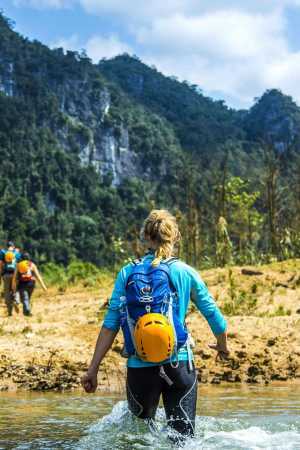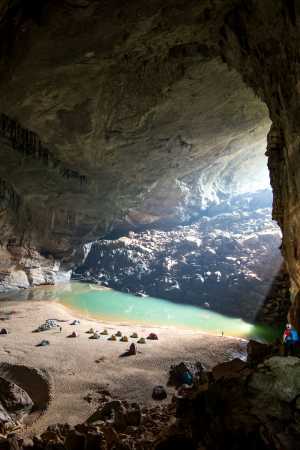It’s shortly after 10 o’clock when our van slows to a halt, lets its passengers out of the air-conditioning and onto the shoulder of an unmarked highway. At first, there seems to be a mistake: Apart from the narrow, empty road that brought us here, there is not a man-made object in sight.
I’m not sure what I was expecting when I signed up for a 22-kilometre trek through the jungle, but I had pictured something more official, at least at the start. A sign, maybe. Nature, of course, does not do signs. For miles around, everything is a single, vibrant shade of green – the ground, the treetops, the plant life tumbling down the mountains in the distance – so I choose to take in the well-rehearsed performance in front of me. Porters extract backpacks and various supplies from the back of the van.
Anetta, our petite, fast-talking, no-nonsense guide, and Lam, her co-guide, usher their charges to the other side of the road. In the air-conditioned comfort of the vehicle, our driver scrolls through his smartphone, peacefully oblivious to everything taking place outside his window.
By the time the sun goes down, I will be sleeping inside the third-largest cave in the world. At three million years old, Hang Én is younger than most other caves in central Vietnam’s Phong Nha-Ke Bang National Park, but its scale is no less impressive. You could park a jumbo jet inside its main chamber and still have room left over. Extending two kilometres into Phong Nha’s limestone mountains, Hang Én is home to an army of swifts, tiny birds known as chim en in Vietnamese that float through the air and are notorious for nesting in high cliffs; they also happen to be the cave’s namesake.
Because Oxalis – the only company to run trips out to Hang Én and its neighbours – takes a leave-no-trace approach to trekking, even one caving trip requires a team of guides, porters, cooks and safety assistants to bring everything from tourists to tents, food and cooking supplies in and out of the jungle, hence the flurry of activity taking place by the roadside on this sunny morning.
And then the chaos is over, just as quickly as it began. A team of porters takes off ahead, disappearing into the trees. The cooks follow close behind, chain-smoking and sporting Vietnam’s standard-issue plastic sandals. Most of the support crew is long gone by the time we pick up our packs and walk directly into the tangle of trees off the road.
Some experts believe there are still undiscovered subterranean chambers that burrow all the way into Laos
In no time at all, the ground slopes away beneath our feet, sending us down a sharp incline. I am covered head-to-toe in a long-sleeved shirt, running tights, and a particularly thick pair of hockey socks – there are leeches, they warned us. The combination of layers and jungle humidity is having an overheating effect on my body temperature. By the time the ground levels off, I am sweating in places I didn’t think it was possible to sweat from.
We emerge from the tree line and into a wide, open landscape of oversized trees and lazy, winding waterways that run through the valley. Of all the elements in the Vietnamese jungle, water is the most powerful: In the dry season the rivers may seem innocuous, but they have tunnelled through 104 kilometres of limestone mountain over the past 400 million years, and that’s only when you count the caves that have been found.
Some experts believe there are still undiscovered subterranean chambers that burrow all the way into neighbouring Laos, dwarfing the likes of Hang Én and its next-door neighbour, Son Doong, the largest cave in the world. Whether or not local explorers happen upon any more underground surprises, Phong Nha is already catching on as a tourist destination.
Its more accessible caves have been popular among Vietnamese travellers for decades, but international visitors are now flocking to the park thanks to a recent spate of positive press, including a television spot on Good Morning America, which broadcast live from Son Doong in 2015, and a starring role in last year’s Kong: Skull Island, parts of which were filmed within the park. But while this attention has brought stronger infrastructure and greater economic opportunities to Phong Nha, that means nature isn’t likely to remain untouched forever.
In an effort to boost tourism, government officials in the area have already proposed a controversial cable car project that would transport visitors through the jungle and out to Son Doong, disrupting much of its surroundings.
For the meantime, Phong Nha’s universal appeal is apparent in our tour group alone: A few western backpackers, a pair of adventurous newly-weds, several schoolteachers and a group of young Hanoian professionals snapping selfies in their wide-brimmed sun hats. My fitness-obsessed parents, their friends and I round out the expedition.
As noon approaches, we stop for lunch in Ban Doong. Home to members of the Bru-Van Kieu, one of Vietnam’s 53 ethnic minority groups, the remote village’s wooden stilt houses look like a mirage amid the lush jungle of its surroundings.
When monsoon season arrives each year and the heavy rains sweep through low-lying areas of Phong Nha, Ban Doong’s 40-odd residents can become cut off from the outside world for days at a time as they wait for the water to recede. Still, there are also some perks to living in the jungle.
As we approach, the matriarch of the village looks up from her hammock, gives us a quick wave, and returns to lounging in the shade while the dishevelled, sweat-drenched group of outsiders staggers by, exhausted from the heat.
We carry on after lunch, wading into seas of tall grass and through the valley’s meandering rivers. At every crossing, our safety assistants ferry the group over to the other side, making sure everyone stays afloat in the ankle-, knee-, and sometimes waist-deep water. Just as we notice the sun beginning to slide closer to the horizon, Anetta stops us and points to the wall of limestone on our left: “There it is.”
They point out a handful of 300-million-year-old fossils etched into the wall
Between the green plant life sprouting off the mountainside and its rough limestone exterior, it takes a moment before I see what Anetta sees, but eventually the entrance to Hang Én comes into view. There’s barely more than a dent in the rock in front of us. After a day’s worth of travel on foot, navigating the jungle in sweltering heat, it is a miracle to me that anyone ever found Hang Én in the first place, let alone the many neighbouring caves.
Anetta and Lam lead us around to a low, wide gash in the side of the rock face, where everyone stops to put on their caving helmets and gloves. Headlamps click on one by one, their tiny points of light bobbing up and down along the walls. As we move deeper into the cave, the sunlight disappears, the temperature drops, and the ground turns upward, forcing us to climb.
It takes a few minutes to scramble over a sea of massive boulders and up to the top of the rock pile, but I eventually arrive and Hang Én’s skylight comes into view, only now it’s enormous: sunlight streams through the opening, illuminating a jaw-dropping cavern, 100 metres high and 180 metres wide. Our cooks, already making dinner down below, are miniature figures on the sand. Dull yellows and greens – the result of mineral deposits – decorate the far wall of the chamber, and the evening’s accommodations – two neat rows of brightly coloured tents – sit on the beach below facing a large, murky pool fed by Hang Én’s underground river.
By the time we reach our tents, the remainder of the day is ours. I find my swimsuit and take a dip in the cool, opaque waters of the cave lake, leaping off a designated rock on the far side. My parents sip tea on the shore and take in their surroundings. When dinner is served, the cooks do not disappoint. We tuck into a feast of Vietnamese rice, meat, tofu and vegetable dishes. Lam produces a clear plastic bottle from his pack – rice wine – and the meal is complete. With the sun gone and the chatter of Hang Én’s resident swift birds fading, everyone turns in early.
The following day, Anetta and Lam lead us away from the natural light of the beach and into Hang Én’s darker chambers, where they point out a handful of 300-million-year-old fossils etched into the walls. Stalactites and stalagmites – eerie, glittering formations – sprout from the ground and hang from the ceiling, while deep grooves cover the cave floor, formed by a combination of time, water, and mineral deposits.
Eventually, we venture back toward the campsite and out into the jungle. On the return trip, Anetta and Lam retrace our route to Ban Doong and back toward that impenetrable green wall shielding Phong Nha from the outside world. Motivated by the prospect of air-conditioning and a cold beer at the top, Lam leads the charge upward. We make it a grand total of six minutes before our first water break. If the going was tough on the way down, it’s nothing compared to the way up. Little by little, our breathless climb continues, broken up by steady water breaks and, once, the interruption of a passing centipede.
It takes an hour or so before the path levels off once more, and we emerge from the trees and onto the same nameless road where we began. The van is waiting on a wide section of the shoulder, our driver leaning against the door and gesturing to an open cooler near the trunk. I crack open a Tiger beer and find a perch on the nearby guardrail. The others appear, one by one, removing their layers as they exit the jungle. By the time the cooler is empty, our van is running and everyone is back into the air-conditioning and we carry on down the road, motoring away and back to reality.


